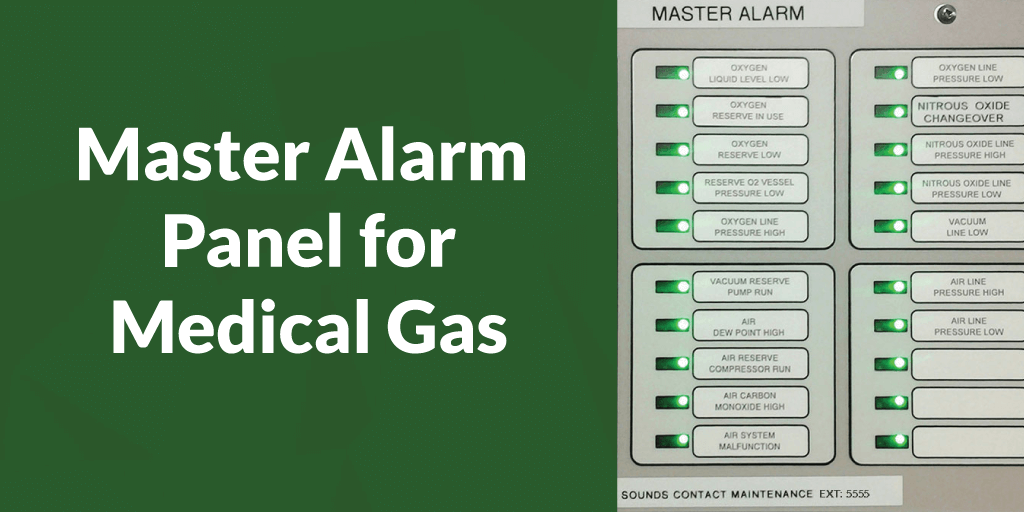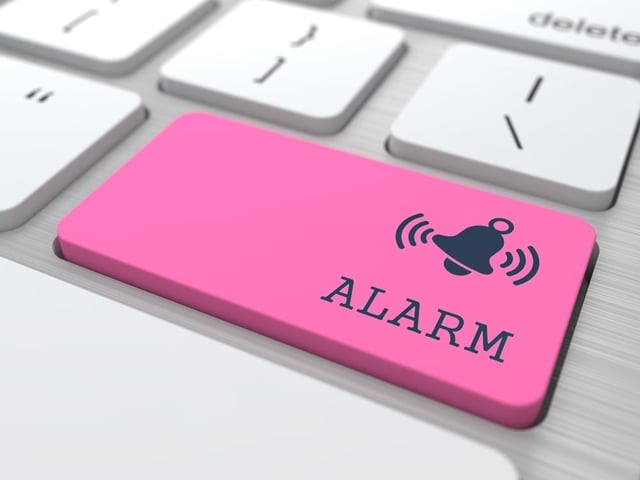
Medical gas supply systems in healthcare facilities provide gases such as oxygen, nitrous oxide, and medical air throughout your facility as needed. These are critical gases for maintaining your patients' wellbeing.
These systems are also monitored with alarms that activate when there is a pressure change or other type of issue that requires attention. The alarms warn of a lack of supply, overall system operation, and the condition of the medical gases being delivered. The master alarms are the most comprehensive of alarm panels and are often monitored by individuals not properly trained on the panel's functionality.
This article will examine the three types of alarms in healthcare facilities, master alarm panel location, first response actions, annual inspections, troubleshooting tips, false alarm situations and how to prevent them, and more.

![]()
Chapters
- 1Three Types of Medical Gas Alarms
- 2Master Alarm Panel Location
- 3What Signals Need to be Present on the Master Panel?
- 4Continuous Med Gas Flow with Annual Inspections
- 5How to Handle Medical Gas Alarm Management
- 6Three Step Action & Trouble Shooting Tips
- 7False Alarm Situations and How to Prevent Them
Chapter 1
Three Types of Medical Gas Alarms
1. Master Alarms – Monitors source equipment. This includes a master alarm panel located where they can be continuously monitored while the facility is in operation.
2. Area Alarms – Monitors the pressure in specific areas or zones.
3. Local Alarms – Monitors a specific alarm condition locally at the piece of source equipment.
Alarms monitor source equipment, areas or zones, and more. At every step, from source to patient, alarms warn of medical gas delivery pressure or malfunctions from a faulty system.
The one place these alarms are often monitored by untrained personnel is at the master alarm.
Chapter 2
Master Alarm Panel Location
One of the required master alarm panels must be located in the office or workspace of the person(s) responsible for maintaining the equipment, often in the facility management office or maintenance shop. NFPA 99 requires the other master alarm panel to be monitored continuously while the facility is in operation, typically at the switchboard or security office in most hospitals.
The individual(s) whose primary responsibility is to transfer calls or provide public safety is also typically required to monitor a panel with dozens of flashing lights and an 80-decibel alarm.
Action Taken - Don't Be Alarmed, Be Prepared
When an alarm is activated, the individual monitoring the panel needs to ask, "What action is required by me?"
Typically, a phone number is posted on or within the panel that will connect them with facilities personnel. It is important for the individual to identify the gas system and alarm condition activated to start you on the path of properly addressing the issue.
Chapter 3
What Signals Need to be Present on the Master Panel?
In many hospitals, the master alarm will have signals to indicate the following conditions:
Oxygen:
- High mainline pressure
- Low mainline pressure
- Low primary liquid level (Less than an average day’s supply)
- Reserve in Use
- Low reserve liquid level (Less than an average day’s supply)
- Low reserve pressure
Manifolds with containers or cylinders (usually nitrogen, nitrous oxide, carbon dioxide), each gas will most often have signals for:
- High mainline pressure
- Low mainline pressure
- Changeover from primary to secondary supply
- Reserve in Use (If reserve header is present)
- Low reserve pressure (If reserve header is present)
Medical Air:
- High mainline pressure
- Low mainline pressure
- High dew point (> 35° F)
- High Carbon Monoxide level* (< 10 ppm)
- High temperature* (operating temperature of the compressor)
- Lag Compressor*
Vacuum:
- Low vacuum pressure
- Lag pump*
Instrument Air:
- High mainline pressure
- Low mainline pressure
- High dew point (> -22º F)
- High temperature at compressor*
- Lag Compressor*
*These signals can be listed on the master alarm as a common alarm (i.e., “Maintenance Required”).
The number of lights and the arrangement can vary depending on the details of the source equipment being used. Some types of pumps require extra alarms, and some backup systems will also require alerting the continuously attended location.
Where there are multiple sources, perhaps in multiple buildings, these sources will also need to be identified on a master alarm. In those cases, facilities should be told which system is alarming as well as the symptom.
Chapter 4
Safeguard Continuous Medical Gas Flow with Annual Inspections
The most important action to be taken by the person that monitors a master alarm is to ensure the correct personnel is immediately called to investigate any active alarm. Telling the person which light is on can save them time to confirm the life-sustaining medical gas continues to flow.
Annual inspections will typically go over the panel to make sure the correct signals are available, and all lights are working. A more thorough inspection will require an actual activation of all pressure switches or actuating devices. This process typically requires multiple people to activate the device and monitor the panels.
NFPA and ASSE require alarm switches to be tested to ensure the functionality of the signals. These tests are done with an advance warning under special conditions
Chapter 5
How to Handle Medical Gas Alarm Management
Do you have a process for safe alarm management and response?
As healthcare facility managers, you need to inspect, check and maintain alarm-equipped devices. The Joint Commission EC.02.05.09, EP 2 requires all master, area, and local alarm systems to comply with the Category 1-3 warning system requirements.
Frequency of Alarm Testing and Maintenance
Master & Local Alarm Actual Activations – Recommended annually per ASSE 6000 and periodically per NFPA 99
Area Alarm Actual Activations – Recommended every 5 years or as determined by risk assessment. Annual activations of analog area alarm panels are recommended to confirm pressure setpoints.
Push Button/Test Button Test – Tests for audible and visual signals to operate at the panel itself, as well as proper pressure setpoints on digital panels. Recommended monthly per ASSE 6000 and periodically per NFPA 99.
Alarm Best Practices
Aging or discontinued alarm panels should be retrofitted or converted to the current model to ensure proper continued maintenance and availability of serviceable parts.
We recommend labeling every Area & Master Alarm with emergency instructions that inform who to contact with just a quick glance. Facilities should establish a personal policy for alarms based on a risk assessment.
CHT recommends keeping these instructions short, concise, and easy to understand for everyone and anyone. For example: When Alarm Activates, Call Maintenance (EXT 0)
See other sections for testing and maintenance and preventing false alarms.
Chapter 6
Three-Step Urgent "First Response" Action and Trouble Shooting Tips

Step 1: If an alarm occurs at an Area or Master Alarm Panel, the first response should be to call the party responsible for reacting to these alarm situations, whether it be Respiratory Therapy or Maintenance/Facilities (or another group designated by your facility.)
This call should be initiated by someone who is currently acknowledging an alarm condition and following the “Emergency Instructions” placed on each and every alarm panel. In addition, there could be a written policy by the facility for Active Medical Gas Alarms.
Step 2: The next step will be for the responsible party to determine what the alarm condition is and what it means, who and where it might be affecting and originating from, and whether it is a real alarm or a potential false alarm.
Once those crucial aspects are derived, troubleshooting steps or problem-solving steps will follow to correct the alarm condition and ultimately return the system back to normal operating status with a “Clear” Alarm Panel (No Current Alarm Conditions, Red Lights, or Audible Alarm Signals).
Step 3: Medical gas systems are complex, and typically a single solution or set of troubleshooting steps will not be effective. Troubleshooting and corrections will depend on the actual alarm condition that is experienced. A medical gas specialist can help develop plans and troubleshooting steps depending on alarm conditions.
Alarm Trouble Shooting Tips
- If an alarm is sounding, check the panel's status first and foremost to verify if this is a “real” alarm.
- Verify pressure output with the zone valve box gauge or other neighboring pressure gauges, pressure readouts, or alarm panels.
- Verify no zone valves are currently closed for this zone or area causing the alarm.
- Verify the source of the gas is functioning properly at the central supply system. Most panels will have a toggle switch, fuse, or power cord that can be used to perform a hard reset on the panel to see if this clears a possible false alarm situation.
- With a set of handheld pressure gauges and flowmeters, test a medical gas outlet/inlet in this zone or area to verify that the proper pressure is being delivered at the patient use point.
- Refer to NFPA 99 for proper pressure and flows for each gas.
Chapter 7
False Alarm Situations and How to Prevent Them
Older alarm panels are known to fail at some point, but when this happens is a mystery. False alarms can be created by faulty annunciator or module boards, loose wires, shorted wires and cables, and even pressure sensors/transducers malfunctioning, just to name a few.
When these parts of old alarm panels malfunction, they often fail, giving false alarms such as a gas high or low-pressure reading alarm. Another malfunctioning alarm panel could discontinue displaying a pressure reading altogether and not actually alarm audibly as some false alarms will.
How to Prevent False Alarms
There is no sure way to prevent all false alarms, as electronics can always display some sort of malfunctioning or inaccurate reading to some extent. But to significantly decrease the chances of being caught by surprise or at a state of shock and worry, a regular medical gas program, along with staying up-to-date with alarm technology, can be the best remedy for preventing false alarms before they occur.
By implementing a medical gas program to regularly test your facility’s area and master alarm panels, you can ensure their proper and consistent functioning and eliminate problems before they arise.
An example would be to perform a push button test on each and every alarm panel on a monthly interval to ensure all audible and visual signals are operating properly as well each area alarm panel is also displaying proper pressure readouts. Any anomalies or issues should be recorded and addressed as they may arise. Documentation of these tests shall be retained until the next test is performed.
In addition to a monthly push button test, performing actual/proper alarm activations annually for master alarms and every 5 years (or sooner) for area alarms is also strongly recommended to ensure proper performance and correct alarm function at the required 20% pressure activation set-points per NFPA 99.
Conclusion
Hospitals are required to inspect, test and maintain the gas sources, the delivery system, and the alarms that monitor the supply. The medical gas systems are life savers. The alarm-equipped devices are essential in providing safety in your healthcare facility.
As simple as the panel of lights may seem, the variety of reasons for them and complications of maintaining them can have a life safety effect.
A CHT inspection will ensure your critical care locations have functional alarms and top-quality patient safety.
If you have questions about what is and what should be on your alarm panels, consult your CHT representative to go through the sources and their backups to keep your healthcare facility safe.




